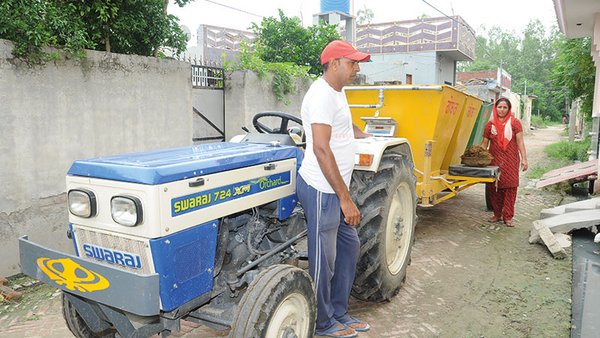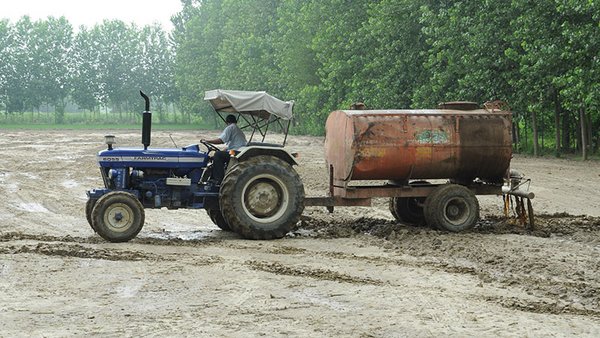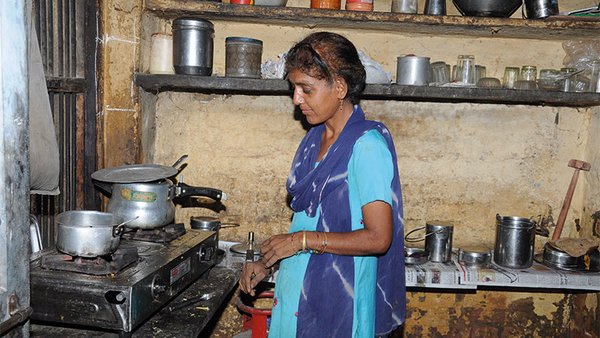 Download this article in magazine layout
Download this article in magazine layout
- Share this article
- Subscribe to our newsletter
From waste to wealth – biomass solutions (not only) for India’s food loss challenge
India has been working hard to find solutions to the problem of food loss and waste and to reduce its extent of post-harvest losses, which amounted to a substantial 926.51 billion rupees (USD 15.19 billion) in 2014. In its efforts to make its food systems more sustainable while covering the rapidly growing energy demand, the country is increasingly opting for using biomass. Research and innovations in the respective technologies have opened doors to convert food waste and agricultural surplus into different valuable products. In the following, we highlight some of the prominent technologies that can harness the power of biomass, offering a sustainable path towards reducing food waste, bolstering food and energy security, and nurturing a circular economy.
Promising approaches
Bioenergy generation for enhancement of food production. Crop productivity in India remains low due to significant reliance on rain-fed agriculture and manual cropping practices, unavailability of advanced irrigation techniques and dependence on expensive fossil fuels such as diesel, coal-based power for transport and power applications. The bioenergy generated in the form of solid, liquid and gaseous biofuels can be used to locally power the critical on-farm energy applications such as irrigation, farm mechanisation, biomass supply chains, fuel for tractors and farm machinery to boost agricultural productivity, and thus overall food production. India has about 228 million tons of annual surplus biomass availability with a biomass power potential of 28 gigawatts (GW). With significant progress thanks to support under several schemes from the Government, the country has already achieved an installed biomass-power capacity of 10.8 GW and more than 300 tons per day of bio compressed natural gas (BioCNG) production.
Reducing food loss and waste by powering the grain storage, cold storage, and preservation infrastructure. A significant portion of food produce perishes because of inadequate post-harvest care. The cold storage options are usually few and far between, leading to horticultural crop wastage and economic losses. With the advances in bioenergy research, decentralised biomass-based cold storage and dryer options are now commercially available which could be owned and operated by local farmers or service providers in rural areas. In the last two to three years, farmers in a few locations in India have started to utilise these biomass-based cold storage solutions. So far, however, not enough farmers have been using these technologies. Further dissemination would be important, for it would help to reduce wastage and loss which in turn would increase farmers’ profitability and overall rural economy while adhering to sustainability principles, as they could store and sell their products year-round.
Organic approaches for boosting sustainable food production and mitigating climate change. In the quest to increase food production, the use of chemical fertilisers on farms has increased significantly in the last few decades. This adversely affects soil health as well as human and livestock health in the long run, along with other harmful effects on the environment because of the fertilisers’ production and transportation processes being highly energy-intensive and emission-emitting. Here, nutrient-rich bio-fertiliser slurry produced along with biogas during anaerobic digestion can be an important organic substituent to the chemical fertilisers as it can lead to enhancement in crop productivity for farmers while restoring soil health and also saving the huge import costs (more than approximately five billion USD a year) of chemical fertilisers for the nation.
Biochar, which is gained from plant material via pyrolysis, is a further interesting option to replace chemical fertilisers, for it can be used to enhance both soil health, harvest yields and wastewater treatment. And finally composting is another well-established method that turns organic waste into nutrient-rich compost, improving soil quality and crop yields. Recognising the importance of biofertilisers from biogas plants, the Government of India launched the Market Development Assistance scheme in September 2023, with a budget of 14.518 billion rupees (approximately 181 million USD) to promote organic fertilisers, and thus sustainable and organic agricultural practices, throughout the country.
Moreover, biomass from food waste finds several other applications in agro-industrial contexts, producing bioplastics, bio-based chemicals, nutritious and sustainable animal feed source, and animal bedding materials. These innovative biomass solutions also tackle urgent problems such as the loss of soil nutrients and the burning of crop residues, which contribute to air pollution. It is important to highlight that burning one ton of paddy straw, for instance, releases 60 kilograms of carbon monoxide (CO), 1,460 kg of carbon dioxide (CO2), 199 kg of ash, 3 kg of particulate matter and 2 kg of sulphur dioxide (SO2), causing significant global warming while also killing important microorganisms in the soil. It also depletes the soil of essential nutrients i.e., nitrogen (5.5 kg), phosphorous (2.3 kg), potassium (25 kg) and sulphur (1.2 kg), as well as other micro-nutrients besides organic carbon.
Numerous options for application
Thus, by reducing the need for burning crop residues and enriching the soil, biomass solutions can provide many useful eco-friendly alternatives. Several important incentives for farmers from the Government of India indicate the support and seriousness which is being emphasised for encouraging the adoption of bioenergy and organic fertiliser options. Government schemes like the National Bioenergy Programme (NBP) and others offer financial assistance and support for bioenergy, bio-fertilisers and sustainable farming practices.
One such example is the Lambra Kangri Multipurpose Cooperative Service Society which provides an entire village with biogas generated from local cow dung (see Box). It is worth mentioning here that while rural areas have very limited kitchen and food waste, as it is a major feed for livestock, in urban areas, similar biogas systems can be installed at the household level to locally manage kitchen waste, in residential societies, offices, hotels and restaurant complexes at community level, so that large amounts of food waste don’t end up in landfills and are locally managed sustainably. The biofertiliser produced thereby can also be used for gardening applications. In recent years, large BioCNG plants with 300 and 550 tons of municipal solid waste treatment capacity per day have also been installed in cities like Pune and Indore respectively, and the BioCNG is used to fuel the public transport buses.
Biogas powering prosperity – the Lambra Kangri village story
Lambra Kangri, a village in Punjab, India, stands as an example of how biogas can be used to achieve rural innovation and sustainable development. At the centre of this transformation is the Lambra Kangri Multipurpose Cooperative Service Society Ltd., which got partial financial support from India’s Ministry of New and Renewable Energy (MNRE).
A cow dung collection trolley. Photo: Jaswinder Singh/ Ambra Kanuri Cooperative Society
In Lambra, the society collects approximately 2,500 kg of cattle dung from the rural residents daily and compensates the farmers at a rate of 8 rupees per 100 kg (approximately 0.1 USD per 100 kg) for this waste. The cattle dung is used to produce biogas and is distributed to more than 40 households every day for cooking applications with the help of pipelines in the village, for daily fixed slots between 5:00 a.m. and 9:00 p.m. The economic benefits are striking, with an average monthly expenditure of only 200 to 300 rupees (approximately 3 USD), significantly lower than the cost of liquefied petroleum gas (LPG). Biogas has emerged as a popular choice in the village for both economic relief and environmental sustainability. In addition, the biofertiliser is used on the village’s fields, which contributes to holistically enhancing the soil health and food production, and brings in an income of approximately 800 rupees (roughly 10 USD) for each tanker load.
A tractor trolley for spraying bio-fertiliser. Photo: Jaswinder Singh/ Ambra Kanuri Cooperative Society
Lambra exemplifies how a simple idea, fuelled by collective determination and supported by governmental initiatives, can not only address energy needs but also create economic opportunities, reduce environmental impact and foster sustainable rural development.
To summarise, biomass is a promising way for India to combat food losses and waste. With the technologies presented, several challenges can be tackled simultaneously. They will prevent food waste, promote sustainable agriculture, improve soil fertility, increase local productivity and reduce the environmental footprint of agriculture.
Vandit Vijay works as a Scientist-C at the SSS-National Institute of Bio-Energy, India. He completed his PhD from IIT Delhi, India, on “Development of a rural energy self-sufficiency model using biomass resources”. Post-PhD, he was associated with TU Delft, The Netherlands as an Outstation Post-doctoral Research Scientist working on carbon neutral coffee plantations.
Santosh Saraswat works as a postdoctoral fellow in the Department of Sustainable Energy Engineering at the Indian Institute of Technology, Kanpur. He has focused on the development of the "National Biomass Atlas" at the SSS-National Institute of Bio-Energy.
Contact: vandit@nibe.res.in




